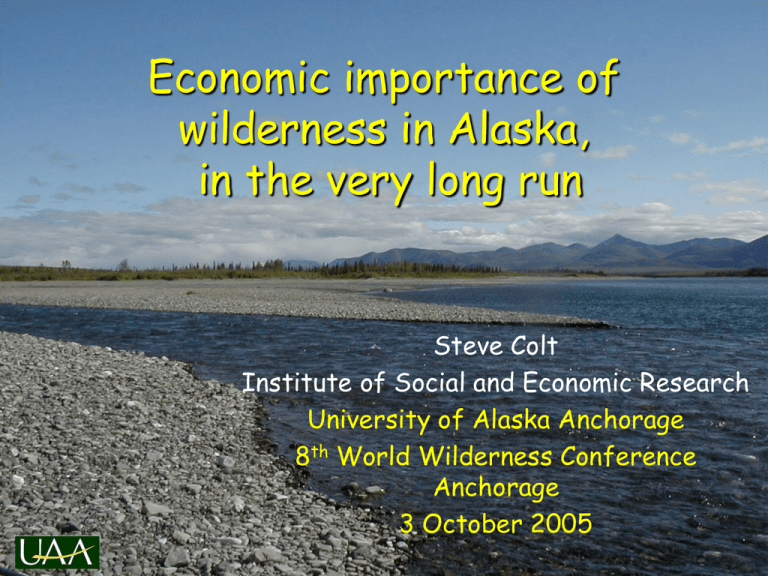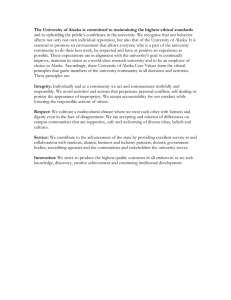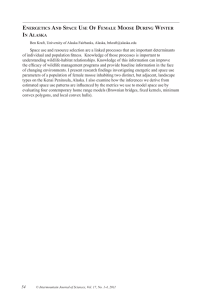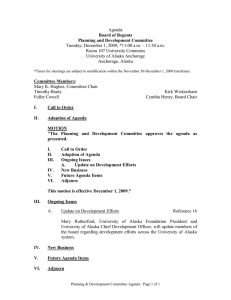Economic importance of wilderness in Alaska, in the very long run Steve Colt
advertisement

Economic importance of wilderness in Alaska, in the very long run Steve Colt Institute of Social and Economic Research University of Alaska Anchorage 8th World Wilderness Conference Anchorage 3 October 2005 Acknowledgments • Alaska Conservation Foundation • University of Alaska Foundation / BP and ConocoPhilips • Darcy Dugan, Hannah Griego, Scott Goldsmith (ISER) • Ginny Fay (Eco-Systems) • Joseph Kalt 2 Preview • Economic benefits of wilderness are uncertain, but growing • Some benefits may have an infinite discounted net present value • It all boils down to: n + y + e + s >= d ????? • If demand is growing fast, can Alaska lands meet it? 3 What on Earth is “Value” ? • Value is subjective “There is no accounting for taste” • Value is determined partly by: Circumstances (water, in the desert; hiking, today) Skills and interests (piano, to Beethoven) Income • Markets reveal value • Economists try to measure value 4 What benefits are we talking about? • Use subsistence recreation ecosystem services • Non-use existence 5 Over what period are we measuring? • [typically] Annual flows of value This year? In 2010? [much better would be]: • Present (discounted (!)(?)) value of all future flows (= asset value) What discount rate? 6 Idea: an infinite legacy • “Environmentalists make lousy neighbors, but they make great ancestors” Attribution can be found in Fox, S. John Muir and his legacy : the American conservation movement 7 Problem with idea: • The cold logic of discounting: • Economic benefits tomorrow do not seem to have the same market value as economic benefits today People are impatient ….You can’t eat the scenery while waiting for its value to soar. 8 Possible Resolution Discounted present value of future benefits of wilderness is infinite What would it take to make this true? 9 Theory • Total value = present value of all future flows of benefits B3 B1 B2 ... 2 3 1 d (1 d ) (1 d ) • Or, forever now Bt t (1 d ) 10 Dismal science result: • If the annual benefits have an upper bound or if they grow more slowly than rate d, then, • The denominators win, and total NPV is finite. forever now Bt V t (1 d ) 11 Not – so dismal result: • If the annual benefits Bt are growing faster than rate d, then… • The numerators win, and the net present value of the total benefits is infinite: forever now Bt (1 d )t 12 In other words: Annual benefits of wilderness might grow faster than the reinvested fruits of any alternative land use (timber, housing, agriculture, etc.) 13 Testing the concept, for Alaska Step 1: Measures of gross economic benefits from Alaska wildlands • About $1.6 billion total nonresident visitor spending (2001) • About $700 million total expenditures on sportfishing (2001) • $2.6 billion of Alaska personal income associated with healthy ecosystems 15 84,000 Alaska Jobs Depend on Healthy Ecosystems (circa 1998) 90,000 80,000 70,000 60,000 Indirect 50,000 40,000 Direct 30,000 20,000 10,000 To ta l To Sp ur is or m tF is h /H un t Re cr ea t io n La nd M gm Su t bs is te nc e Co m m .F is h - 16 Example: Tourism Industry (nonresident demand) 17,000 direct jobs 26,000 total jobs, circa 2001 17 Step 2: Attribution of total value to “wilderness” or “wildness” 18 Why do People Visit Alaska Why do People Live in Alaska? 19 The Denali advantage • Visitors to Denali in summer 2001 stayed in Alaska 14 days, on average, while all other visitors spent only 8 days, on average. • Denali visitors spent $2,300 per party per trip, compared with only $1,100 spent by all other visitors. • These people are here for the wildlife, not the nightlife 20 Case Study: Seward Economy (ISER 2001) • Seward wage and salary employment grew at 3.7% per yr between 1980 and 2000, vs. 2.6% for entire State. • Kenai Fjords Park visits: 21 Step 3: Growth rates • Use value Depends on visitors And in-migrants • Existence value Depends on population, income per capita, and education 22 Average annual growth rates • Summer Visitors to Alaska 1989 - 2004: 6% • Cruise passengers to Alaska 1989 – 2004: 12% 1,600,000 air, highway, ferry 1,400,000 Cruise 1,200,000 1,000,000 800,000 600,000 400,000 200,000 20 03 20 01 19 99 19 97 19 95 19 93 19 91 19 89 0 23 Recreation visits to AK National Parks avg annual growth = 7.6% 2,500,000 2,000,000 1,500,000 1,000,000 500,000 Source: http://www2.nature.nps.gov/stats/ 2003 2001 1999 1997 1995 1993 1991 1989 1987 1985 1983 1981 1979 0 24 Average annual growth rates • Visitors to all Alaska national parks 1980 - 2004: 7.6% • Visitors to pre-ANILCA parks [1960-62] – [2002-04] Glacier Bay: 15% Denali: 7% Katmai: 12% All three together: 9% 25 Recreation visits by park 500,000 450,000 400,000 350,000 300,000 250,000 200,000 150,000 100,000 50,000 0 Denali Glacier Bay Kenai Fjords 2003 2000 1997 1994 1991 1988 1985 1982 1979 1976 1973 1970 Wrangell St Elias 26 Growth: soft adventure …guided rafting on Chugach National Forest 16% average annual growth for Six-mile River 8000 Client days 7000 6000 Sixmile 5000 Granite/Portage Kenai 4000 Copper River 3000 2000 1000 0 1994 1995 1996 Year 1997 1998 27 Average annual growth rates • Real per capita income, 1960-2000 World: 2.2% Richest billion people: 2.7% China: 4.3% • Real total income, 1960-2000 World: 4.1% Richest billion people: 3.8% China: 6.0% 28 U.S. Educational Attainment Share of adults with some college or more: 1984: 39% of adults 2001: 53% 29 Average annual growth rates • Real-dollar sales by the Alaska Natural History Association: 1960-2004: 16% 1980-2004: 11% 30 Step 4: The Reckoning Growth rate of annual benefits Bt = growth of population +growth of per capita income +growth of education +growth of Alaska market share (fewer substitutes) = (n + y ) + e + s But, what about d? • Direct use value: n + y + e + s = growth of tourists = at least 10% • Ecosystem services value ??? Need help from the ecologists • Existence value: (n+y) + e + s = at least 4 + 1 + 1 = at least 6% • But, what about d? 32 Real rates of return on invested capital • U.S. 10-yr Treasury Bonds 1953 - 2004: 2.6% 1960 - 2000: 2.8% • Alaska Permanent Fund 1984 - 2004: 7.0% 33 The Alaska challenge: • Alaska healthy ecosystems are increasingly scarce from a global perspective, but: • First, they are still viewed as relatively abundant by most Alaskans “I have plenty of wilderness outside my home in Peters Creek.” • Second, how can we get the growing direct use benefits without “killing the golden goose?” 34 The reckoning, summary • T-Bond rate = 3% Existence benefits growth = 6% • AK permanent fund = 7% Use benefits growth = 10% (+) 35 This talk is at: www.iser.uaa.alaska.edu ~The End Slides from Economics of tourism Recreation Industry (residents) • Hard/impossible to measure - overlaps with tourism and sport fishing • Important to many residents as a key benefit of living in Alaska (“permanent tourists”) 7,200 direct jobs 9,800 total jobs 38 Overall Tourism Growth has Slowed Summer Visitor Arrivals 1989-2001 (May - September) 600 500 Cruise 400 Domestic Air 300 Highway 200 Ferry 100 2001 1999 1998 1997 1996 1995 1994 1993 1992 1991 1990 1989 thousands of arrivals 700 39 Guided and Charter-Supported Kayak Trips in PWS Index (1987-88=1.0) 8.0 7.0 Blackstone (P22) 6.0 Harriman (P09) 5.0 Culross Perry (P26) 4.0 Nellie Juan (P25) 3.0 Knight Island (P27) 2.0 Eshamy (P30) 1.0 0.0 1987 1988 1989 1990 1991 1992 1993 1994 1995 1996 1997 1998 Year 40 Capturing the Value • The Potential: Average AK $ per person per trip? $1,258 in 2001 Of which, how much on gifts/souvenirs? $119 how much on Alaska Native arts/crafts? $92 How much on clothing? $58 41 Slides from AWRTA April Denali NP Money Generation (2001): • 218,085 visitor days in 2001 $22 million total spending 445 direct average annual jobs • But this is just time IN the park Source: Michigan State U, http://www.prr.msu.edu/mgm2/ 43 MGM Appears Conservative: $23 million Source: ISER ANILCA and Seward economy 44 Kenai NWR: • $21 million on-site expenditures • PLUS, $28 million additional sport fishing expenditures depend on refuge habitat • $49 million total 950 jobs 45 What is the Effect of Designation? • Loomis (1999): Effect of Add’l Wilderness designation on NPS and USFS lands For a 1% increase in designated W, NPS usage per capita increased by 0.6% For a 1% increase in designated W, USFS usage per capita increased by 0.89% Source: Loomis, Society & Nat. Resources, 12(5) Jul/Aug 1999 46 Effect of Designations…. • Weiler & Seidl (2004): Looked at 8 monuments that were switched to parks between 1979 and 2000. Controlling for other economic changes, Re-designation increased use by 5% or 11,000 visitors per park per year. 47 Effect of Designations…. • Costa Rica in 1980s designated 20% of its entire territory as national parks • Send me there and I will report back to you….! 48 Slides from ANILCA paper



